Merthyr Tydfil (via the Penydarren tram road) to Newport (34 miles)
1st leg- Penydarren tram road
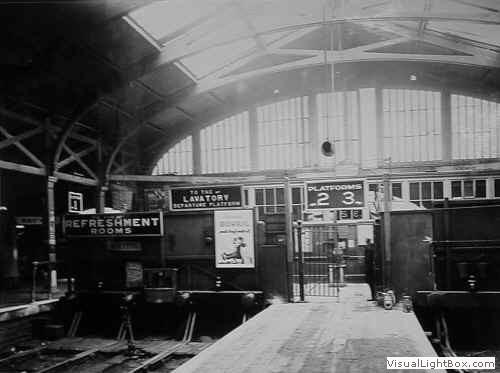 Northern UK had been hit by snow all week, but in the south we were managing to avoid the deluge. I kept
an eye on a live web cam of Merthyr Tydfil; no snow and it looked sunny. We caught the train from Newport to
Merthyr Tydfil, a Welsh town steeped in history from the industrial revolution. The second replacement station
in Merthyr was built by Isambard Kingdom Brunel and was situated in the high street, it was a terminus for the
Neath and Brecon railway. In the seventies a new third station was built, but lost the romance of Brunel’s
old station. Merthyr was at one time the largest iron producing area in the world, spawning a spider’s web of
canals, tram roads, and railways. It will be these we will be cycling along, most are devoid of cars, but the
trails are broken making the route cross roads and circumvent modern developments.
Northern UK had been hit by snow all week, but in the south we were managing to avoid the deluge. I kept
an eye on a live web cam of Merthyr Tydfil; no snow and it looked sunny. We caught the train from Newport to
Merthyr Tydfil, a Welsh town steeped in history from the industrial revolution. The second replacement station
in Merthyr was built by Isambard Kingdom Brunel and was situated in the high street, it was a terminus for the
Neath and Brecon railway. In the seventies a new third station was built, but lost the romance of Brunel’s
old station. Merthyr was at one time the largest iron producing area in the world, spawning a spider’s web of
canals, tram roads, and railways. It will be these we will be cycling along, most are devoid of cars, but the
trails are broken making the route cross roads and circumvent modern developments.
We left the station and were looking forward to seeing the Penydarren tram road, the temperature
was around 5 degrees centigrade, and the sky was overcast, but dry. The first part of the ride was on
minor roads, traffic free but a bit grubby. We turned onto the National cycle route 477, a smooth track,
but not flat; it ambles up and down the hill side.
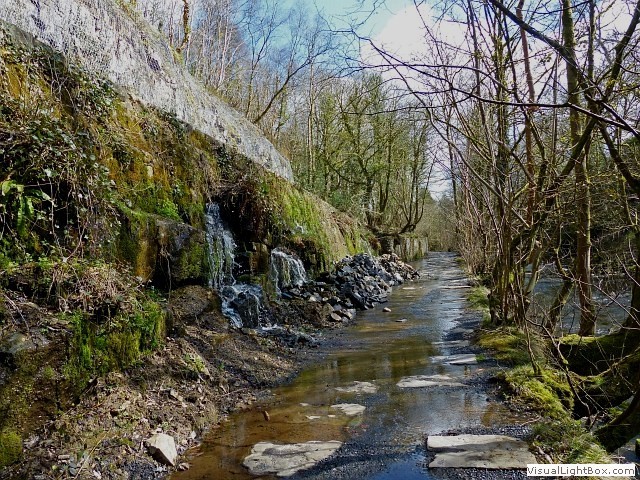 We came to a pedestrian bridge crossing the A4060, the bridge had artwork depicting Richard Trevithick’s
tram (best seen from the road side), here the trail became more interesting and so did the weather; it
began to sleet heavily. We travelled along the very same route where Trevithick made history by driving
his high pressure steam tram engine, together with five wagons containing 10 tons of iron and 70 men from
Penydarren to Abercynon. This was the first steam engine in the world to pull a load on rails on the 21st
February, 1804. The trail now follows the low lying course of the river Taff, the 200 year old stone
sleepers are still visible.
We came to a pedestrian bridge crossing the A4060, the bridge had artwork depicting Richard Trevithick’s
tram (best seen from the road side), here the trail became more interesting and so did the weather; it
began to sleet heavily. We travelled along the very same route where Trevithick made history by driving
his high pressure steam tram engine, together with five wagons containing 10 tons of iron and 70 men from
Penydarren to Abercynon. This was the first steam engine in the world to pull a load on rails on the 21st
February, 1804. The trail now follows the low lying course of the river Taff, the 200 year old stone
sleepers are still visible.
At Quakers yard we crossed the river Taff twice, to cut across a horseshoe in the river and after crossing another river on a foot bridge, the Taff Bargoed River, we head towards Treharris. Leaving the tram road and joining the bed of the Taff Vale railway at the site of the Deep Navigation Colliery. We crossed the Taff Bargoed again on the impressive Millennium Park footbridge, with the river thundering underneath in a manmade furrow. Near here on the 12 December 1884, five men descended the No.2 South shaft in Deep Navigation colliery in a bowk (bucket) to replace some byats (safety harnesses). Just after the winding engine commenced, a braided steel rope broke (nearly 4 inches thick), sending four men to their deaths at the bottom of the shaft 700 yards below. But they weren’t the only men who lost their lives here; 110 men died over a period of one hundred years at the pit.
We pass the old Penalta colliery on the left, now another landscaped park and on to the
impressive viaduct at Hengoed. The grade II listed viaduct has 16 arches, and is 284 yards
long, soaring high above the valley, constructed in 1854.
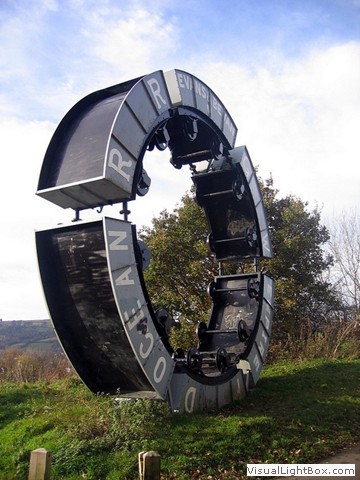 On the Maesycwmmer side of the viaduct is an incredible ‘wheel o’ drams’, a fitting monument to
the coal industry (the drams are small tram trucks used underground in the mines). After the
viaduct we crossed the road back onto the railway path which follows the main A472, here I
sustained a rear puncher. On investigation the cause was a ‘U’ shaped cable clip, in my opinion
the only reason this would be here on the path, is to cause punchers. Way to go. Before heading
down the Sirhowey valley we took a short diversion along Heoldu Road to Gelligroes Mill, once a
traditional flour mill, now it is a candle workshop by Royal appointment, but it still has a
working water wheel and worth a little peek.
On the Maesycwmmer side of the viaduct is an incredible ‘wheel o’ drams’, a fitting monument to
the coal industry (the drams are small tram trucks used underground in the mines). After the
viaduct we crossed the road back onto the railway path which follows the main A472, here I
sustained a rear puncher. On investigation the cause was a ‘U’ shaped cable clip, in my opinion
the only reason this would be here on the path, is to cause punchers. Way to go. Before heading
down the Sirhowey valley we took a short diversion along Heoldu Road to Gelligroes Mill, once a
traditional flour mill, now it is a candle workshop by Royal appointment, but it still has a
working water wheel and worth a little peek.
2nd leg- Sirhowy valley
We now travel alongside the Sirhowy river on the original tram route which was converted to full gauge and eventually run by the GWR, above this junction there were 18 collieries and there were 5 below, now sadly all are gone, very little evidence survives of a once laborious industry. Mid way along the tarmac track I sustained a front puncher and pinched the replacement tube. Eventually we were rolling again.
At the end of the Sirhowy track we turn off to the left and went down to the river level, after a short distance we found ourselves on Islwyn road. Islwyn road was the site of the infamous Black vein colliery, it was known as the fiery pit as it sustained many fires here due to fire damp (an explosive methane gas), the worst explosion killed 146 men and boys in 1860. The victims are commemorated with a rather poor and badly worn memorial stone on the other side of the valley in a mass grave on the Risca mountainside. The Merthyr to Risca section was a very enjoyable ride with some great scenery and no hint of the coal pits that the route was built on, all have been transformed into landscaped parks, or improvised motorbike tracks. The ride commentary might seem melancholy, talking about the loss of life, and it’s facile to dwell on a bygone era, but it’s a bit too easy to forget the past with nothing more than inscribed pieces of rock to recall the true price of Welsh coal.
3rd leg- Mon and Brecon canal (Crumlin arm)
We turn right off Islwyn road and head through Waunfawr park on to the National cycle route 47, over the recently reopened railway lines to Ebbw Vale, then up a short climb on to the Crumlin arm of the Monmouthshire and Brecon Canal. It’s strange, as this leg is a branch off the ‘said’ canal, but doesn’t go near Brecon. We turn right on to the canal, left and it will take you all the way to the Cwmcarn forest drive, a great route we do all the time. This way the canal goes all the way to Newport and is a good surface. The path crosses Darren bridge which allowed transport from a lime quarry, a brickworks, and Darren colliery, to the left is a cafe and campsite at Whysom Wharf.
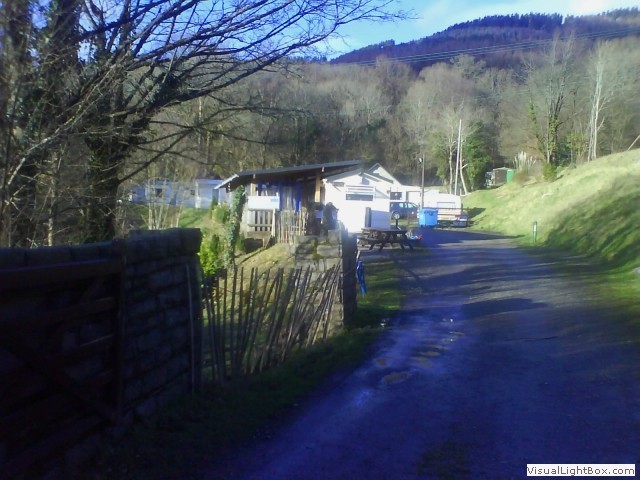 We had a well earned cup of tea here before moving on. Further on, we passed underneath Moriah Chapel
bridge, this was built over the canal to allow parishioners to attend the Moriah Baptist church in Risca,
renowned as the first Welsh church to preach in English. I can imagine the riot that caused. Just before
the route takes us down hill past Fourteen Locks, there is visitor centre situated at the top of a unique
flight of restored locks in Rogerstone, here one can have tea and hire cycles. After yet more tea we’re
off again, we cross the bridge at Pensarn where the lock keepers cottage is situated. Imagine, lock keepers
usually look after a few locks, these locks are on a big hill, he would have to walk up and down all day; wow
exhausting. We rode under the M4 and continued on alongside the canal, a few more miles to Newport Bridge,
where I parted with my riding buddy.
We had a well earned cup of tea here before moving on. Further on, we passed underneath Moriah Chapel
bridge, this was built over the canal to allow parishioners to attend the Moriah Baptist church in Risca,
renowned as the first Welsh church to preach in English. I can imagine the riot that caused. Just before
the route takes us down hill past Fourteen Locks, there is visitor centre situated at the top of a unique
flight of restored locks in Rogerstone, here one can have tea and hire cycles. After yet more tea we’re
off again, we cross the bridge at Pensarn where the lock keepers cottage is situated. Imagine, lock keepers
usually look after a few locks, these locks are on a big hill, he would have to walk up and down all day; wow
exhausting. We rode under the M4 and continued on alongside the canal, a few more miles to Newport Bridge,
where I parted with my riding buddy.
I must say it’s been great, the punchers were a pain in the arse, but I thoroughly enjoyed all 34 miles from Merthyr to Newport.
-
Gallery
 Why not have a look at the gallery relating to this ride. Click the image or the title.
Why not have a look at the gallery relating to this ride. Click the image or the title. -
Royal visit
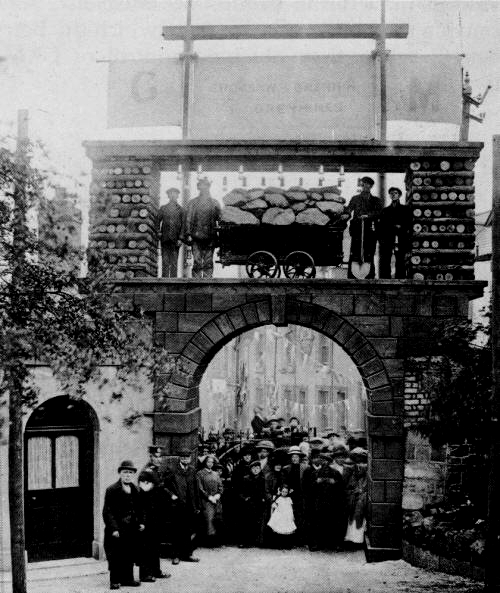 In 1912 King George V and Queen Mary visited Dowlais works. They entered the works on foot, through
an arch made entirely of coal. The arch was built from locally mined coal which was then constructed
into an arch by Dowlais Works Craftsmen. Today a heritage group have unveiled plans to reconstruct
the famous coal arch.
In 1912 King George V and Queen Mary visited Dowlais works. They entered the works on foot, through
an arch made entirely of coal. The arch was built from locally mined coal which was then constructed
into an arch by Dowlais Works Craftsmen. Today a heritage group have unveiled plans to reconstruct
the famous coal arch. -
Robin Bastards
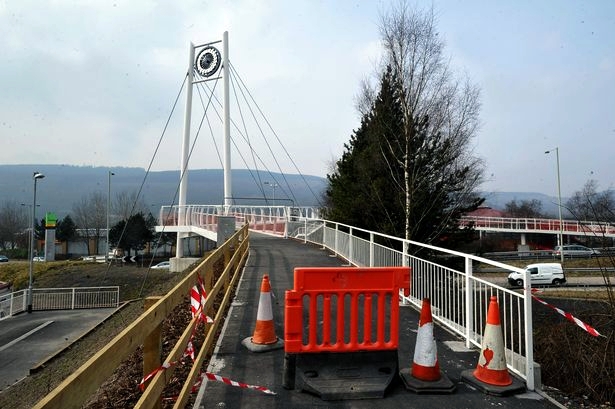 A year after it was opened, Puddlers Bridge, the crossing over a major road making a traffic free route
for the Trevithick Trail had to be closed after 900 metres of metal was stripped from it. Thieves made
off with huge chunks of stainless steel wire forcing authorities to close the bridge. Unbelievable.
A year after it was opened, Puddlers Bridge, the crossing over a major road making a traffic free route
for the Trevithick Trail had to be closed after 900 metres of metal was stripped from it. Thieves made
off with huge chunks of stainless steel wire forcing authorities to close the bridge. Unbelievable. -
Quakers Yard
 The name Quaker's Yard was, obviously, linked to the Quaker religion. Persecution and punishment of
these 'Dissenters', groups such as the Baptists and Quakers was common in the 19th century. Most
cyclists going through Quakers Yard have little or no knowledge of the origins of this peaceful
village with the quaint sounding name.
The name Quaker's Yard was, obviously, linked to the Quaker religion. Persecution and punishment of
these 'Dissenters', groups such as the Baptists and Quakers was common in the 19th century. Most
cyclists going through Quakers Yard have little or no knowledge of the origins of this peaceful
village with the quaint sounding name. -
Titanic
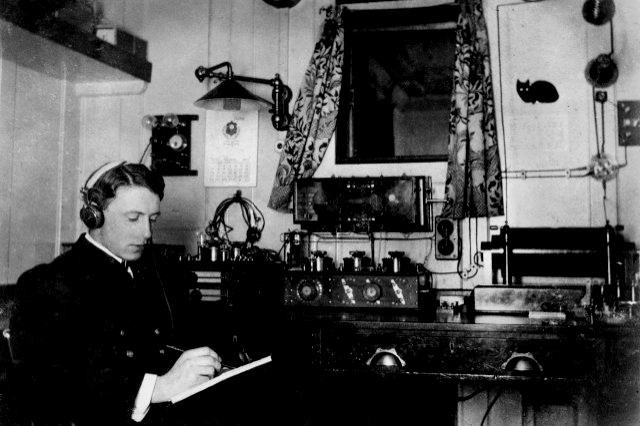 Distress signals from the stricken Titanic were first picked up by an amateur radio enthusiast
near Caerphilly. Arthur "Artie" Moore turned his hand to amateur radio at Gelligroes Mill. He
picked up the distress signal and ran to the local police station where he had trouble convincing
the constabulary that he really had picked up "messages in the air".
Distress signals from the stricken Titanic were first picked up by an amateur radio enthusiast
near Caerphilly. Arthur "Artie" Moore turned his hand to amateur radio at Gelligroes Mill. He
picked up the distress signal and ran to the local police station where he had trouble convincing
the constabulary that he really had picked up "messages in the air". -
Salmon return to Sirhowy River
 Salmon have laid eggs in the River Sirhowy for the first time since the mining industry began in
the Valleys. Following a conservation campaign, nests have been spotted in Blackwood after the river
was made more fish-friendly. The Atlantic salmon have not been able to swim up river from the Atlantic
and Irish Sea in around 100 years, due to pollution from mining, and industry, and from manmade
barriers in the river such weirs. The environment agency wish to stress Grizzly Bears have not
been seen yet.
Salmon have laid eggs in the River Sirhowy for the first time since the mining industry began in
the Valleys. Following a conservation campaign, nests have been spotted in Blackwood after the river
was made more fish-friendly. The Atlantic salmon have not been able to swim up river from the Atlantic
and Irish Sea in around 100 years, due to pollution from mining, and industry, and from manmade
barriers in the river such weirs. The environment agency wish to stress Grizzly Bears have not
been seen yet. -
The price of Welsh coal.
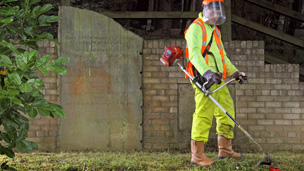 Young offenders inadvertently rediscovered an 1860 Risca mine tragedy stone plaque. The undergrowth was
cut back as punishment to reveal the inscription of the men and boys killed at the
colliery. Offenders on a probation service community payback scheme did not know it was there. The
memorial was found on a hillside overlooking the Old Black Vein Colliery at Risca.
Young offenders inadvertently rediscovered an 1860 Risca mine tragedy stone plaque. The undergrowth was
cut back as punishment to reveal the inscription of the men and boys killed at the
colliery. Offenders on a probation service community payback scheme did not know it was there. The
memorial was found on a hillside overlooking the Old Black Vein Colliery at Risca. -
Newport medieval ship
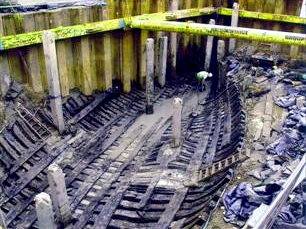 In 2002 during the foundation work of a new theatre on Newport riverfront, the most complete and
preserved 15th century ship was found. It was painstakingly excavated and is now being conserved
in a Newport warehouse. Evidence suggests it was a merchant ship trading along the seaboard of the
western Atlantic as far south as Spain. It also seems likely that the Ship was built in south-west
France, the Basque country, Asturias or Portugal.
In 2002 during the foundation work of a new theatre on Newport riverfront, the most complete and
preserved 15th century ship was found. It was painstakingly excavated and is now being conserved
in a Newport warehouse. Evidence suggests it was a merchant ship trading along the seaboard of the
western Atlantic as far south as Spain. It also seems likely that the Ship was built in south-west
France, the Basque country, Asturias or Portugal.

 In 1912 King George V and Queen Mary visited Dowlais works. They entered the works on foot, through
an arch made entirely of coal. The arch was built from locally mined coal which was then constructed
into an arch by Dowlais Works Craftsmen. Today a heritage group have unveiled plans to reconstruct
the famous coal arch.
In 1912 King George V and Queen Mary visited Dowlais works. They entered the works on foot, through
an arch made entirely of coal. The arch was built from locally mined coal which was then constructed
into an arch by Dowlais Works Craftsmen. Today a heritage group have unveiled plans to reconstruct
the famous coal arch. A year after it was opened, Puddlers Bridge, the crossing over a major road making a traffic free route
for the Trevithick Trail had to be closed after 900 metres of metal was stripped from it. Thieves made
off with huge chunks of stainless steel wire forcing authorities to close the bridge. Unbelievable.
A year after it was opened, Puddlers Bridge, the crossing over a major road making a traffic free route
for the Trevithick Trail had to be closed after 900 metres of metal was stripped from it. Thieves made
off with huge chunks of stainless steel wire forcing authorities to close the bridge. Unbelievable. The name Quaker's Yard was, obviously, linked to the Quaker religion. Persecution and punishment of
these 'Dissenters', groups such as the Baptists and Quakers was common in the 19th century. Most
cyclists going through Quakers Yard have little or no knowledge of the origins of this peaceful
village with the quaint sounding name.
The name Quaker's Yard was, obviously, linked to the Quaker religion. Persecution and punishment of
these 'Dissenters', groups such as the Baptists and Quakers was common in the 19th century. Most
cyclists going through Quakers Yard have little or no knowledge of the origins of this peaceful
village with the quaint sounding name. Distress signals from the stricken Titanic were first picked up by an amateur radio enthusiast
near Caerphilly. Arthur "Artie" Moore turned his hand to amateur radio at Gelligroes Mill. He
picked up the distress signal and ran to the local police station where he had trouble convincing
the constabulary that he really had picked up "messages in the air".
Distress signals from the stricken Titanic were first picked up by an amateur radio enthusiast
near Caerphilly. Arthur "Artie" Moore turned his hand to amateur radio at Gelligroes Mill. He
picked up the distress signal and ran to the local police station where he had trouble convincing
the constabulary that he really had picked up "messages in the air".  Salmon have laid eggs in the River Sirhowy for the first time since the mining industry began in
the Valleys. Following a conservation campaign, nests have been spotted in Blackwood after the river
was made more fish-friendly. The Atlantic salmon have not been able to swim up river from the Atlantic
and Irish Sea in around 100 years, due to pollution from mining, and industry, and from manmade
barriers in the river such weirs. The environment agency wish to stress Grizzly Bears have not
been seen yet.
Salmon have laid eggs in the River Sirhowy for the first time since the mining industry began in
the Valleys. Following a conservation campaign, nests have been spotted in Blackwood after the river
was made more fish-friendly. The Atlantic salmon have not been able to swim up river from the Atlantic
and Irish Sea in around 100 years, due to pollution from mining, and industry, and from manmade
barriers in the river such weirs. The environment agency wish to stress Grizzly Bears have not
been seen yet.  Young offenders inadvertently rediscovered an 1860 Risca mine tragedy stone plaque. The undergrowth was
cut back as punishment to reveal the inscription of the men and boys killed at the
colliery. Offenders on a probation service community payback scheme did not know it was there. The
memorial was found on a hillside overlooking the Old Black Vein Colliery at Risca.
Young offenders inadvertently rediscovered an 1860 Risca mine tragedy stone plaque. The undergrowth was
cut back as punishment to reveal the inscription of the men and boys killed at the
colliery. Offenders on a probation service community payback scheme did not know it was there. The
memorial was found on a hillside overlooking the Old Black Vein Colliery at Risca.  In 2002 during the foundation work of a new theatre on Newport riverfront, the most complete and
preserved 15th century ship was found. It was painstakingly excavated and is now being conserved
in a Newport warehouse. Evidence suggests it was a merchant ship trading along the seaboard of the
western Atlantic as far south as Spain. It also seems likely that the Ship was built in south-west
France, the Basque country, Asturias or Portugal.
In 2002 during the foundation work of a new theatre on Newport riverfront, the most complete and
preserved 15th century ship was found. It was painstakingly excavated and is now being conserved
in a Newport warehouse. Evidence suggests it was a merchant ship trading along the seaboard of the
western Atlantic as far south as Spain. It also seems likely that the Ship was built in south-west
France, the Basque country, Asturias or Portugal.